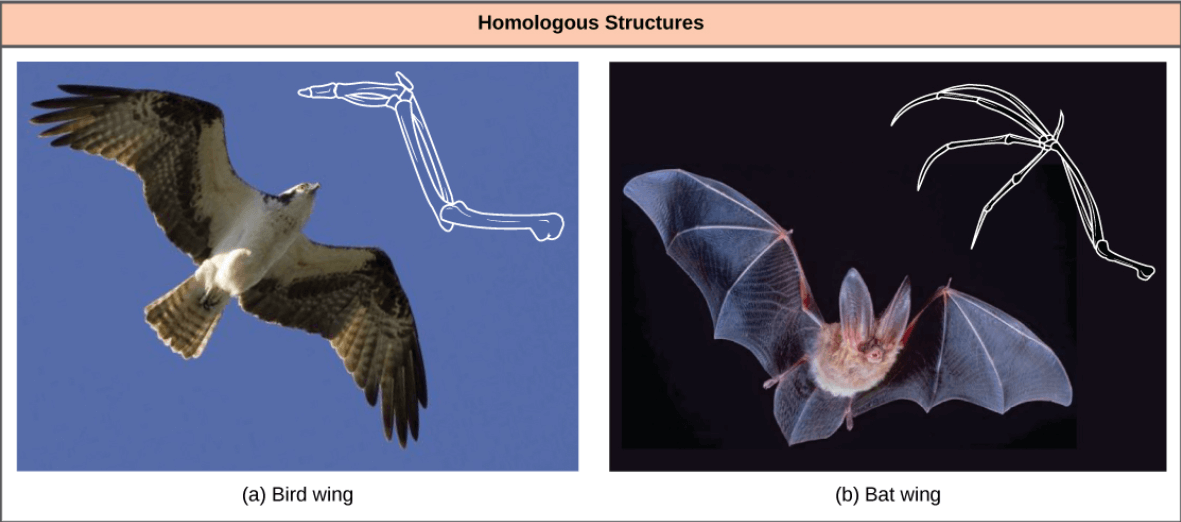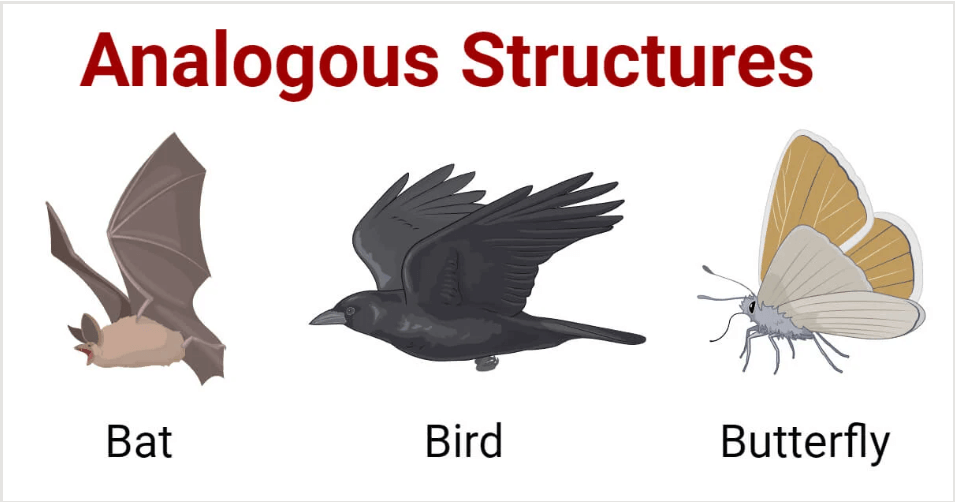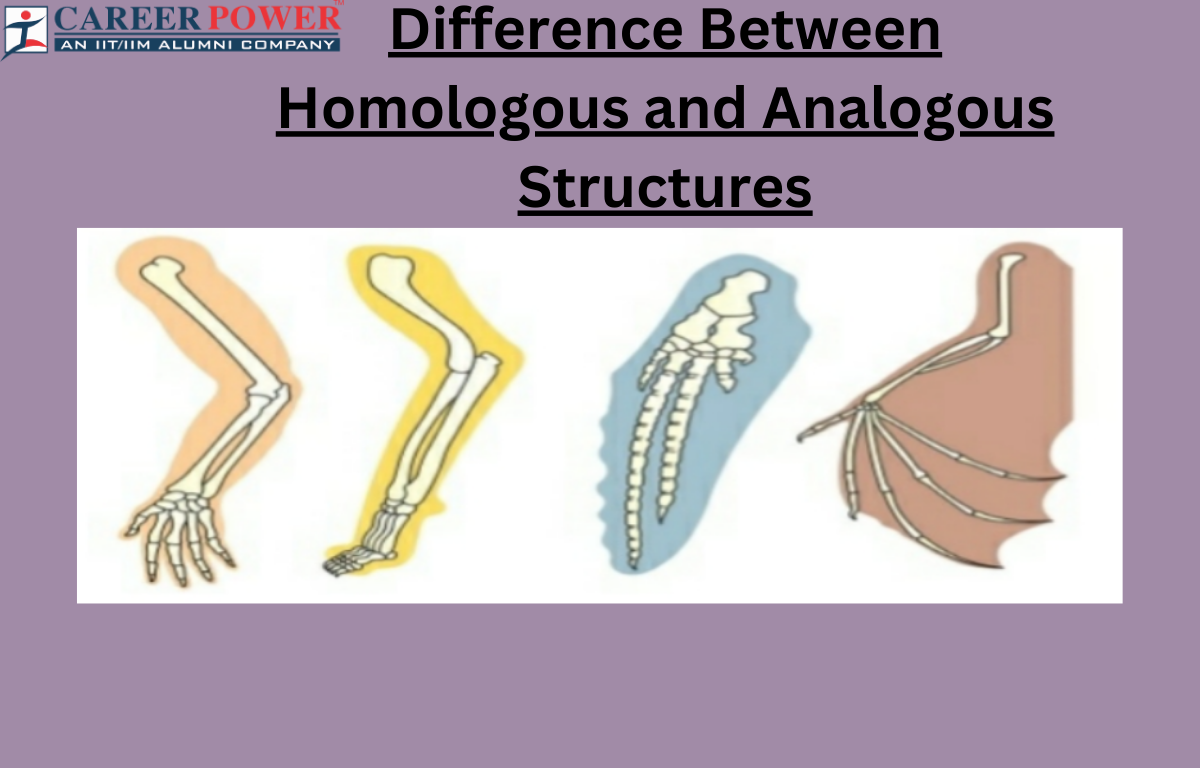Homologous structures are body parts in different organisms that have similar structures, suggesting that have similar structures, suggesting a common evolutionary ancestor. For example, the human arm and a bat’s wing have similar bones, indicating a shared ancestor. Analogous structures, on the other hand, are different in structure but serve similar functions. Birds wings and butterfly wings are analogous structures because they have different origins but both allow flight. Here we have briefly explained a few differences between homologous and analogous structures.
Homologous and Analogous Structures
Homologous and analogous structures are important concepts in biology that refer to different types of similarities between organisms. Homologous structures provide evidence of common ancestry, indicating evolutionary relationships between organisms. Analogous structures, on the other hand, are the result of convergent evolution, where different species independently evolve similar traits to adapt to similar environmental challenges.

What are Homologous structures?
Homologous structures are anatomical features in different species that have a similar underlying structure or origin, often despite serving different functions. These similarities suggest that the species sharing homologous structures have a common evolutionary ancestor. These structures may have different forms and functions in various organisms, but they share a fundamental structure due to their shared ancestry.

For example, the bones in the forelimbs of humans, bats, whales, and birds are considered homologous structures. Despite the different functions these forelimbs serve (such as grasping, flying, and swimming), they have a similar skeletal structure, indicating that these species share a common ancestor with limbs possessing this particular arrangement of bones.
The presence of homologous structures provides strong evidence for the theory of evolution, showing that different species have inherited these structures from a common ancestor and have adapted them over time to suit their specific needs and environments.
What are Analogous Structures?
Analogous structures are anatomical features in different species that have similar functions but do not share a common evolutionary origin. In other words, these structures have evolved independently in different species due to similar environmental pressures, rather than being inherited from a common ancestor. Analogous structures often arise through a process called convergent evolution. In convergent evolution, different species independently evolve similar environments or face similar ecological challenges.

For example, the wings of bats and the wings of birds are analogous structures. Both bat wings and bird wings serve the function of flight, but they have different underlying structures and evolutionary origins. Bats are mammals, and their wings are formed from a membrane of skin stretched over elongated finger bones. Birds, on the other hand, are avians, and their wings are formed from feathers.
Analogous structures highlight the remarkable ability of organisms to adapt to their environments, even if they are not closely related genetically. The existence of analogous structures does not provide evidence for a close evolutionary relationship between the species possessing them; instead, it demonstrates the power of natural selection in shaping organisms to suit their specific habitats and lifestyles.
Difference Between Homologous and Analogous Structures
Homologous structures and analogous structures are terms used in the field of Biology to describe different types of similarities between organisms. Homologous structures indicate shared ancestry and evolutionary relationships, while analogous structures reflect similar functions that evolved in different lineages without a common ancestor. Here we have shared a few differences between homologous and analogous structures in table form:
| Difference Between Homologous and Analogous Structures | ||
| Aspects | Homologous Structures | Analogous Structures |
| Definition | Homologous Structures are structures derived from a common ancestor. | Analogous structures are structures with similar functions but different evolutionary origins. |
| Evolutionary Origin | Homologous structures have the same evolutionary origin, diverged over time. | Analogous structures have different evolutionary origins and evolved separately. |
| Anatomy | Homologous structures are similar in structure but may have different functions. | Analogous structures are similar in function but may have different structures. |
| Genetic Basis | Homologous Structures have similar genetic basis and developmental pathways. | Analogous structures have different genetic basis and developmental pathways. |
| Example | An example of a Homologous structure is the human arm and bat wing similar bones, with different functions. | An example of a bat wing and an insect wing have different structures and similar functions. |
| Evolutionary Path | Homologous structures give evidence of common ancestry in different species. | Analogous structures give evidence of Convergent evolution due to similar environments. |
| Common Ancestry | Related species share homologous structures. | Unrelated species share analogous structures. |
| Divergence Time | Homologous structures are diverged over a long period of evolutionary time. | Analogous structures are evolved independently in relatively short time spans. |
| Adaptive Significance | Homologous structures reflect evolutionary relationships and shared ancestry. | Analogous structures have adaptations to similar environmental challenges. |
| Occurrence | Homologous structures are found in organisms that share a common evolutionary history. | Analogous structures are found in organisms that live in similar environments. |
Importance of Homologous and Analogous Structures
Homologous and analogous structures are important concepts in evolutionary Biology and comparative anatomy. Understanding these concepts helps scientists trace the evolutionary history of species, decipher their adaptations, and gain insights into the mechanisms that shape biological diversity.
Importance of Homologous Structures
Homologous structures are important in several ways. Homologous structures serve as a fundamental concept in the field of biology, providing compelling evidence for evolution, guiding comparative anatomy studies, and aiding research in various scientific disciplines.
- Evidence of Evolution: Homologous structures provide structures provide strong evidence for the theory of evolution. The similarity in structure among different species suggests a common ancestry, supporting the idea that organisms have evolved from a common ancestor over millions of years.
- Divergent Evolution: The existence of homologous structures in diverse species illustrates the concept of divergent evolution. Divergent evolution occurs when two or more related species become more dissimilar over time due to different environments or selective pressures. Homologous structures help scientists understand how species with a shared ancestor have diversified into various forms and functions.
- Comparative Anatomy: Studying homologous structures allows scientists to compare the anatomy of different organisms. This comparison provides valuable relationships between species. By examining homologous structures, scientists can classify organisms into related groups and construct phylogenetic trees, which depict the evolutionary history of species.
- Predicting Common Ancestry: Homologous structures enable scientists to predict common ancestry between organisms. Similarities in the bone structure of vertebrate limbs, for example, indicate a common ancestor despite the different functions (such as wings in birds, flippers in whales, and arms in humans). This understanding helps researchers reconstruct the evolutionary paths of various species.
- Medical and Genetic Research: Knowledge of homologous structures is crucial in medical research and genetics. Understanding the similarities and differences in structures among different species can provide insights into human anatomy and diseases. It also aids in studying genes and their functions across different organisms, including humans, leading to advancements in medical treatments and genetic therapies.
Importance of Analogous Structures
Analogous structures are important in several ways. Some of there importance have been discussed here:
- Convergent Evolution: Analogous structures provide evidence for convergent evolution, where unrelated species independently evolve similar traits or functions due to similar environmental challenges. This phenomenon illustrates the power of natural selection in shaping organisms to adapt to specific ecological niches.
- Adaptation and Survival: Analogous structures highlight how organisms adapt to their environments. Different species facing similar environmental pressures develop similar traits, demonstrating the significance the significance of adaptation in survival. Studying analogous structures helps scientists understand how organisms thrive in diverse habitats.
- Functional Adaptation: Analogous structures emphasize function over evolutionary history. Even though these structures may have different origins, they serve similar functions. This functional adaptation showcases the efficiency of natural selection in producing solutions to specific biological problems, promoting the survival and reproduction of organisms.
- Bioengineering and Biomimicry: Analogous Structures Inspire Innovations in bioengineering and biomimicry. Engineers and designers often look to nature for solutions to complex problems. By understanding how analogous structures function in different organisms, scientists can develop technologies and designs that are more efficient, sustainable, and environmentally friendly.
- Understanding Ecological Roles: Analogous structures provide insights into the ecological roles of different organisms. Organisms with analogous structures often occupy similar niches in different ecosystems, playing comparable roles in food chains, energy transfer, and ecosystem stability. Studying these structures aids ecologists in understanding the intricacies of various ecosystems.



 50 Vegetables Name for Kids in English a...
50 Vegetables Name for Kids in English a...
 Food Chain: Definition, Types, Examples,...
Food Chain: Definition, Types, Examples,...
 Human Respiratory System: Definition, Di...
Human Respiratory System: Definition, Di...













